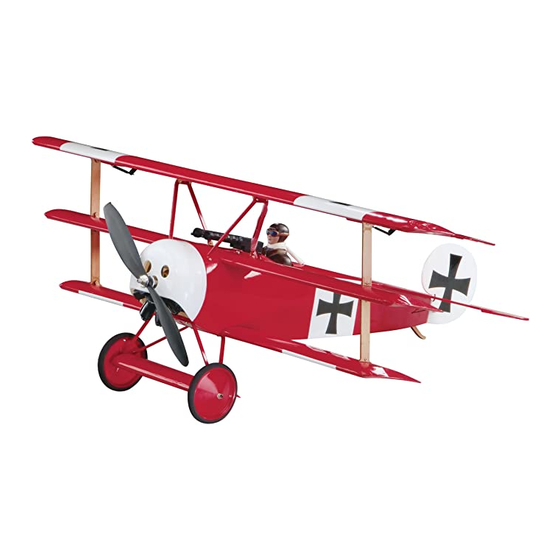- ページ 17
おもちゃ GREAT PLANES fokker DR-1のPDF 取扱説明書をオンラインで閲覧またはダウンロードできます。GREAT PLANES fokker DR-1 20 ページ。

Balance the Model Laterally
❏
1. With the wing level, lift the model by the prop shaft
and the bottom of the fuse under the TE of the fuse. Do this
several times.
❏
2. If one wing always drops when you lift the model, it
means that side is heavy. Balance the airplane by adding
weight to the other wing tip. An airplane that has been laterally
balanced will track better in loops and other maneuvers.
PREFLIGHT
Identify Your Model
No matter if you fl y at an AMA sanctioned R/C club site or
if you fl y somewhere on your own, you should always have
your name, address, telephone number and AMA number
on or inside your model. It is required at all AMA R/C club
fl ying sites and AMA sanctioned fl ying events. Fill out the
identifi cation tag on the back cover page of this manual and
place it on or inside your model.
Charge the Transmitter Batteries
Follow the battery charging instructions that came with your
radio control system to charge the transmitter. You should always
charge your transmitter the night before you go fl ying, and at
other times as recommended by the radio manufacturer.
CAUTION: Unless the instructions that came with your
radio system state differently, the initial charge on new
transmitter batteries should be done for 15 hours using
the slow-charger that came with the radio system.
This will "condition" the batteries so that the next charge
may be done using the fast-charger of your choice. If the
initial charge is done with a fast-charger, the batteries may
not reach their full capacity and you may be fl ying with
batteries that are only partially charged.
Balance the Propellers
Carefully balance your propeller and spare propellers before
you fl y. An unbalanced prop can be the single most signifi cant
cause of vibration that can damage your model. Not only
will motor mounting screws and bolts loosen, possibly with
disastrous effect, but vibration may also damage your radio
receiver and servos.
We use a Top Flite Precision Magnetic Prop Balancer
(TOPQ5700) in the workshop and keep a Great Planes
Fingertip Prop Balancer (GPMQ5000) in our fl ight box.
Proper Care of Your Motor
Using multiple battery packs to run the motor for successive
fl ights may cause the motor to become excessively hot. We
recommend at least a 10-minute motor cool-down period
between fl ights.
Before the fi rst fl ight, inspect the model closely to make sure
all screws remained tight, the hinges are secure, the prop is
secure and all pushrods and connectors are secure.
Ground check the operational range of your radio before the
fi rst fl ight of the day. With the transmitter antenna collapsed
and the receiver and transmitter on, you should be able to
walk at least 30m [100'] away from the model and still have
control. Have an assistant stand by your model and, while
you work the controls, tell you what the control surfaces are
doing. Repeat this test with the motor running at various
speeds with an assistant holding the model, using hand
signals to show you what is happening. If the control surfaces
do not respond correctly, do not fl y! Find and correct the
problem fi rst. Look for loose servo connections or broken
wires, corroded wires on old servo connectors, poor solder
joints in your battery pack or a defective cell, or a damaged
receiver crystal from a previous crash.
MOTOR & BATTERY SAFETY PRECAUTIONS
Failure to follow these safety precautions may result
in severe injury to yourself and others.
Use safety glasses when running the motor.
Do not run the motor in an area of loose gravel or sand; the
propeller may throw such material in your face or eyes.
Keep your face and body as well as all spectators away from
the plane of rotation of the propeller as you run the motor.
Keep these items away from the prop: loose clothing, shirt
sleeves, ties, scarfs, long hair or loose objects such as
pencils or screwdrivers that may fall out of shirt or jacket
pockets into the prop.
Always remove the LiPo (Lithium-Polymer) battery from the
plane before charging.
™
Always use a charger designed to charge LiPo batteries for
charging the LiPo fl ight battery.
17
